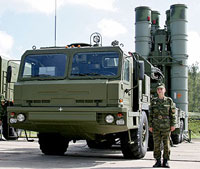Russia's S-400 System Strikes Imagination and Everything Else in the Sky
Russia’s S-400 Triumf missile system was put into service in 2007. The new system has recently appeared in the Moscow region, in the town of Electrostal to strengthen the defense of the Moscow missile defense area. Russia’s Air Force Commander, Lieutenant-General Vadim Volkovitsky, described the S-400 system as a “child complex that needs to develop and grow.”

S-400 can strike any air target at a distance of up to 400 kilometers around, except for nuclear warheads of intercontinental ballistic missiles.
The “child complex” looks very impressive. The launch system with four missiles looks like a tractor that carries pipes for an arterial pipeline.
Designers of the system say that S-400 can operate automatically. For the time being, there are only two of such systems in the Moscow region. Most likely, they will take part in the Victory Day parade on Moscow’s Red Square on May 9.
“The exploitation of the new system has shown that this is reliable military hardware. This system is familiar to our specialists. Some of its parts and equipment were used on its predecessor, S-300, which simplifies the training process for personnel. Putting Triumf into service did not require the participation of many specialists, like it happened with S-300 system. There are some minor technical problems as it always happens with new things, but they all are not relevant,” the official said.
S-400 Triumf is designed for the destruction of various types of aircraft (planes, helicopters, missiles) including those made with the use of Stealth technology. The system also destroys short-range attack missiles and missile warheads flying at the speed of up to 4.8 kilometers per second. S-400 is three times more efficient than similar complexes of both Russian and foreign production.
“I can assure you that there is no other missile system in the world that could be better than Triumf. I constantly study the materials of other countries’ armies and compare Russian hardware with state-of-the-art military hardware of other countries. I can say that no other country has approached Russia at this point,” Yury Soloviov, the commander of Russian Special Assignment Troops said.
The S-400's NATO reporting name is SA-21 Growler, and the system was previously known as S-300PMU-3. It overshadows the capabilities of the other systems from the S-300 series, and its range is claimed to be at least two times the MIM-104 Patriot system's.
The S-400 is expected to be superseded by the future S-500 missile, with development expected to be completed by 2012.
A regular S-400 battalion reportedly consists of at least eight launchers with 32 missiles and a mobile command post.
On 8 February 2008, Lt. Gen. Vladimir Sviridov announced that Russia will be replacing the S-300 systems in the Northwest of Russia with the more technologically advanced S-400. This could mean that Russia plans for this system to be in place and represent a major component of their ballistic missile defense system until 2020.
A simplified version of the S-400 is also targeting the export market, with China reportedly already having spent $500 million on it. It has also been reported China may have been part of the development process. Russia has also offered the system to the United Arab Emirates and Greece. After showing of the S-400 during the IDEF 2009 in Istanbul Turkey has expressed interest in buying the system.
Perhaps the biggest impact for in particular the United States is nations like Iran expressing interest in the system. Vice Chairman of Russia's State Duma Vladimir Zhirinovsky has urged the fast delivery of the S-400 anti-aircraft missile systems to Iran. Such a move is likely seen as bolstering ties between Moscow and Tehran, something Washington has found difficult to deal with.
Russia currently operates 2 battalions as of 2009, and intends to arm 5 more battalions in 2010.
Russia Today: S-400 anti-missiles to shoot down falling North Korean rockets
Subscribe to Pravda.Ru Telegram channel, Facebook, RSS!



